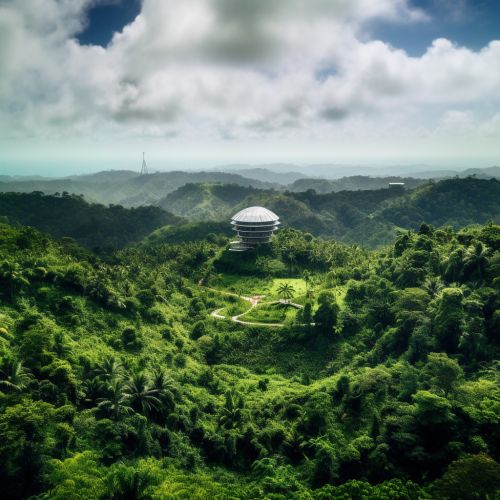Arecibo Observatory
Overview
The Arecibo Observatory is a radio telescope located in the municipality of Arecibo in Puerto Rico. This observatory is operated by the University of Central Florida (UCF) in collaboration with Universidad Ana G. Méndez and Yang Enterprises, Inc., under a cooperative agreement with the National Science Foundation (NSF).


History
The Arecibo Observatory was initially built under the direction of Professor William E. Gordon from Cornell University, with the purpose of studying the Earth's Ionosphere. The construction of the observatory began in the mid-1960s and was completed in 1963. The observatory was under the management of Cornell University until 2011, when the management was transferred to SRI International. In 2018, the management was transferred to the current operators.
Design and Features
The Arecibo Observatory features a fixed 305 m (1,000 ft) diameter dish constructed in a natural sinkhole. The dish is constructed of perforated aluminium panels that are supported by a mesh of steel cables. The observatory's receiver is located 150 m (492 ft) above the dish and is supported by a platform and a system of cables running from three concrete towers. The design of the observatory allows it to observe radio waves from different directions by moving the receiver, rather than the dish.
Scientific Contributions
The Arecibo Observatory has made significant contributions to the field of Astronomy. In 1964, the observatory was used to determine the rotation period of Mercury, which was later confirmed by spacecraft observations. In 1968, the observatory was used to discover the first binary pulsar, a discovery that led to important confirmations of the theory of general relativity. The observatory has also been used to search for extraterrestrial intelligence (SETI) and to track asteroids that could potentially impact the Earth.
Recent Developments and Future
In recent years, the Arecibo Observatory has faced several challenges. In 2017, the observatory was damaged by Hurricane Maria, but it was repaired and returned to service. In 2020, two cable failures resulted in significant damage to the dish and the receiver platform. The NSF announced that the observatory would be decommissioned due to safety concerns. However, there are ongoing efforts to rebuild the observatory and restore its scientific capabilities.
